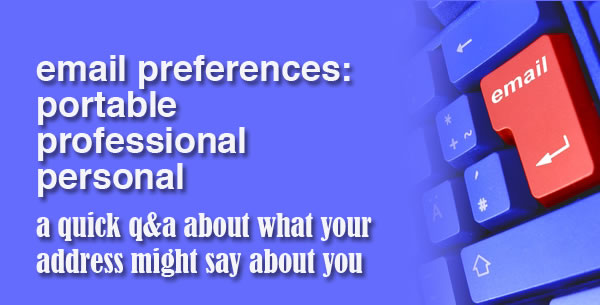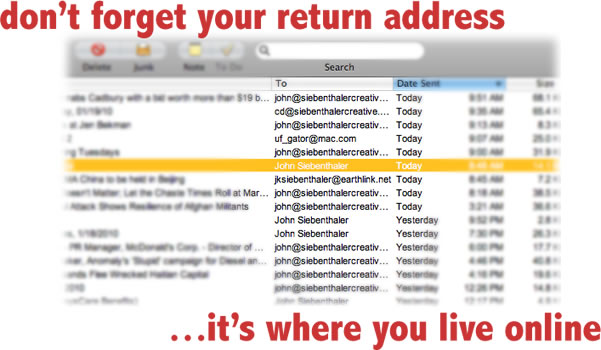
@YourDomain.com: Name It To Claim It
John Siebenthaler
update: Google's latest privacy initiatives illustrate the pros and cons of depending on a non-hosted email strategy.
Find more brand insight here and here

my internet experience started with a CompuServe subscription. CIS (as it was known) used local phone exchanges to deliver content over a dial up modem at 2400kbs. If you were on the road there was a toll-free 800 number used to retrieve a local number you then connected to by jacking into the phone terminal with a MacGyver kit of tiny screwdrivers and alligator clips.
As stand-alone networks gave way to the web, I bailed out and chose Earthlink as my ISP provider. The address that came with it was used as an alternate for awhile, along with my mac.com — still in use — addresses.
The need for high speed meant choosing either a local dsl (copper) or cable subscription. I chose Time Warner – now Brighthouse – cable over Verizon’s dsl.
4-Step Unique E-Mail Creation
1. Register your own unique URL. Don’t rush. It’s almost guaranteed your first, second and tenth choices are already taken but don’t give up; be creative. Explore alternative names. Once you’ve secured your own domain you have total control over your email choices.
2. The temptation is great but resist the urge to go with anything other than a "dot-com" or "dot-net" domain. Unless you’re absolutely sure your domain will be for email only, lower tier URLs like “name@name.biz” are mostly ignored by search engines.
3. Select a host. Hosts sell server space that delivers your uploaded content in response to web requests. Check if they offer CP control panel, a versatile tool which makes site administration and customization a lot easier.
Research the details of turnkey sites offering all in one registration, hosting and EZ setup based on themed templates. Pitfalls include incorrectly added subdomains that can result in blacklisting.
4. Once you’ve selected your host, you’re set. Use an existing template, design your own or commission a custom site design; host your own blog; install a Content Management System (CMS). A properly optimized home (index) html page by itself can work wonders as a unique beacon shining your individual light throughout the internet. Congratulations! You now have your own unique “@i.d.”
for more on creating a successful web strategy contact siebenthaler creative
“Users won’t be able to opt out. If they don’t like the change, Google has said, they can avoid signing into their accounts or stop using Google products altogether. ”
your email – your brand Professional communication strategies include social, blog, chat, text and even phone. But the one medium that underpins all the above is email. The strongest current in the broad river that makes up our digital connectivity — chit-chatting to the planet about family, job, interests and goals — email (alt. e-mail) sets the tone for our image, online and beyond.
go beyond “ocho8t56@gmail.com” For most of us, email is the first step – the point of contact – in starting a conversation and the essential link in maintaining one. Before settling for the ubiquitous web (or ISP) standard issue @gmail.com or @yahoo.com, consider how that dovetails with the image you’re projecting.
Karla Gower, associate professor of advertising and public relations at the University of Alabama, says that “Social media platforms, such as MySpace, Facebook and Twitter, have changed the way people communicate and behave,” by greatly expanding the opportunity for one-to-one communication.
sorry — that name’s taken You don’t really need an ISP (Internet Service Provider). Alternatives are a dependable hangout offering free WiFi for your away from home office courtesy of Google or Yahoo.
Here's the problem. You may want the name Mom called you to dinner by, but guaranteed it's already taken. The usual scenario has “Jeff” ending up as “jeFf3592”. On a business card? Not what you’d want as first choice for brand building.
Web mail’s fine for students, online registrations and teasing out phishers, but for projecting a professional image you need your name in front of a unique, memorable, domain. (There are instances, though, where you would want a web or ISP issued address, usually arising from employer mandates involving social networks.)
claim your own domain When you invest $15 or so annually for a domain, you’ve staked a claim to your own unique identity. It’s your brand — whether it’s corporate, storefront or individual, you’ll be judged by appearance and content, only now it’s digital, manageable, customizable and permanent as long as the domain is maintained.
Aside from immediacy, there’s a very practical aspect to operating out of your own domain — 100% portability. If you’re dependent on an ISP (earthlink, cox, verizon, rr) issued address, it’s only as good as your account status. Move, change providers or just decide to drop out and you’ll lose it and your audience.
The downside is that without a little IT support, setting up and definiing a domain based e-mail could turn into a frustrating exercise because of the particular skills required. The good news? If you’re able to settle for basics, it’s an easy path to learn.




